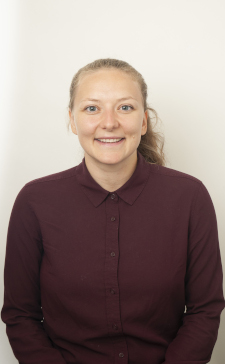Three PhD students from the Department of Mathematics are attending the 3MT
In the 3 Minute Thesis Competition (3MT), PhD students present their research project in only three minutes with just one static slide for an audience of non-specialists.
The three PhD students are Ragnhild Ørbæk Laursen, Emil Dare and Nikolaj Nyvold Lundbye.
The three PhD theses presented:
Ragnhild Ørbæk Laursen
Title: Are you confident in your data analysis?
"It is very important to make the right analysis of your data to obtain the correct conclusions. In my PhD thesis, I have looked at one of the most popular methods to analyze big data called non-negative matrix factorization. This method is, for example, used to analyze big collections of DNA from different blood samples and determine whether patients have different cancers in their body. One mostly unknown fact is that this model can give different solutions for the same data set. This is not because the model is used in a wrong way, but simply because the model contains a lot of free parameters. It is important to know all of these solutions to be sure to make the right conclusions about your data. One solution could, for example, tell you that you have a certain cancer in your body and another could tell you that you do not. Only knowing one of these solutions would be critical, but knowing both will inform you about the possible instabilities in the solution. In my PhD thesis, I have developed an algorithm you can apply to your solution, and it will let you know of all the other solution that exist, if there is any."
Emil Dare
Title: Stereologically Adapted Crofton Formulae
"In my PhD thesis, I delve into stochastic geometry, where I derive Crofton formulae. In a beautiful interplay between geometry and integral theory, these formulas connect geometric properties of an object with intersections of the object, which have a lower dimension. In the construction of these formulae, multiple branches of mathematics are intertwined, making the subject highly intriguing. The derived formulas can also find practical applications. They give rise to methods for estimating the properties of 3-dimensional figures from, for example, a collection of 2-dimensional sections. This is particularly relevant in microscopy, where cells are observed in a microscope. The 3-dimensional cell is not directly visible; instead, 2-dimensional sections are observed. It is precisely the Crofton formulas that enable the estimation of properties such as volume, surface area, and general orientation of cells based on a collection of such 2-dimensional images.
Nikolaj Nyvold Lundbye
Title: How many holes should your data set have?
“In my PhD thesis, I am studying collections of points which are scattered completely at random. The points could represent anything - cells in the blood, trees in a forest or stars in the universe. Rather than being interested in the precise location of the points, I am more interested in their overall shape, for example, if they form a circle or not. In particular, in the field of”Topological Data Analysis" that I am working in, we are interested in the number of holes. I am currently working on proving that in this completely random setup, how many holes would we expect and where are the holes likely to be. This result can be used to determine confidently if points seen in a microscope or on a satellite image are random or if there is some underlying structure. Or in other words, if you’re looking at a random part of the universe or not."
About the 3MT Competition
The competition will be held in Stakladen at Aarhus University on 13 March 2024. Everyone is welcome to join physically or virtually.
The 3MT was founded at University of Queensland, Australia, in 2008 and is held over 900 universities across more than 85 countries. The video of the performance of the internal AU winner will be submitted to the international competition held by the Coimbra Group of more than 35 European universities. A Coimbra Group panel will then select the top three candidates, who will be invited to present at the Coimbra Group annual conference where the winner will be found. In 2024, the 3MT international competition will be held on 6 June in Turku, Finland.
The competition has been won internationally by PhD students from Aarhus University in 2022 and last year in 2023(!).



![[Translate to English:] Nikolaj Nyvold Lundbye](/fileadmin/Files/News/2024/3MT_Nikolaj.png)